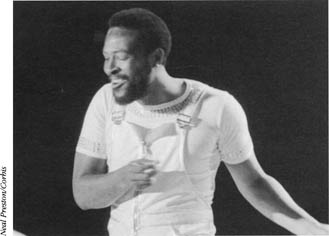
Marvin Gaye in concert during a tour at the height of his solo career in the 1970s.
Marvin Gaye was a gifted singer-songwriter who embodied all the turbulent changes that soul music underwent from the 1950s through the 1980s. He was born on April 2, 1939, in Washington, D.C. His father was a charismatic preacher in the Apostolic Church, and from an early age Marvin sang gospel in the choir. At the age of 18, Gaye joined Harvey Fuqua’s Moonglows group and eventually made his way to Detroit, where he signed a contract with Berry Gordy of Motown Records (he also married Gordy’s sister, Anna, in 1961).
Gaye worked on Motown sessions and tours as a pianist and drummer, then began a two-decade run of successful singles and albums as a solo vocalist for Motown with “A Stubborn Kinda Fellow” in 1962. Gaye also started writing songs, with “Dancing in the Street” for Martha Reeves and the Vandellas in 1964. That same year, he began the first of four duet partnerships with popular Motown artist Mary Wells. He went on to record duets with Kim Weston, Tammi Terrell, and Diana Ross.
In 1968, Gaye began his evolution from supportive duet partner to explosive solo artist, beginning with “I Heard It Through the Grapevine,” the most successful Motown single (in terms of sales) of the entire decade. That year, Gaye also began work on his “social manifesto” album What’s Going On, which took him nearly three years to complete. Focusing on the environment, the war in Vietnam, and the war in the urban ghettos, the album redefined both the subject matter and the attitude of soul music. It also opened up soul to the realm of the concept album, and advanced the use of multi-tracked vocals, as Gaye provided harmony and backup to himself. During this period, Gaye suffered personal trauma when Tammi Terrell collapsed in his arms while they were performing together in Virginia. She was suffering from a brain tumour. After her eventual death in 1970, Gaye became deeply depressed and retired briefly from the music scene. However, What’s Going On, written, arranged, sung, and performed by himself (with an orchestra), was a universal success when it was released in 1971.

Marvin Gaye in concert during a tour at the height of his solo career in the 1970s.
Re-emerging after the success of What’s Going On, Gaye’s next album, Let’s Get It On (1973), was about physical pleasure. The tension between his physical nature and his religious background was growing. In 1978, Gaye signed over all the royalties from a double-album, Here My Dear, to Anna as a divorce settlement. The album catalogued their stormy relationship. Two years later, he ended his contract with Motown with the album In Our Lifetime (1981). Deeply in debt to the Internal Revenue Service, he immediately signed with Columbia Records and released a startlingly explicit ballad, “Sexual Healing,” from Midnight Love (1982).
Despite his professional success, Gaye’s personal life was in ruins. Suffering from depression and paranoia induced by cocaine abuse, he returned to his parents’ home where he was shot dead by his father during an argument on April 1, 1984.
Chris Slawecki
SEE ALSO:
BLUES; GOSPEL; MOTOWN; SINGER-SONGWRITERS; SOUL.
Ritz, David. Divided Soul: The Life of Marvin Gaye
(London: Omnibus Press, 1995).
I Want You;
Let’s Get It On;
Live at the London Palladium;
Midnight Love; What’s Going On;
You’re All I Need to Get By.